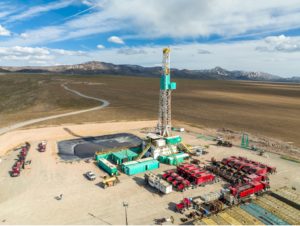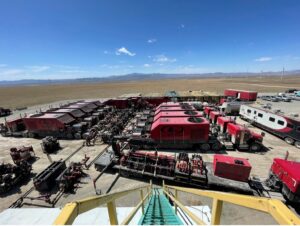
Researchers at the University of Utah’s FORGE project have achieved a significant milestone in the development of the nation’s largest underground field laboratory for Enhanced Geothermal System (EGS) technologies — they created the first successful hydraulic fractures near the bottom of an injection well. This proves hydraulic stimulation is viable in extreme-temperature environments.
“This was an unprecedent technical success that resulted from more than a year of planning and the interaction of numerous researchers, vendors, the Department of Energy, industrial advisors, and service providers,” said University of Utah chemical engineering professor John McLennan, co-principal investigator for FORGE (Frontier Observatory for Research in Geothermal Energy). “It is a crucial step in the fifty-year journey to successfully develop an Enhanced Geothermal System.”
Conventional geothermal energy production — a form of renewable energy in which heat deep underground turns water into steam for turbines — relies on a trifecta of geologic conditions: heat at a relatively shallow depth, open and conductive natural fractures, and an abundance of heated fluid. Yet these criteria only exist together in a small portion of the United States.
However, in an Enhanced Geothermal System, you can drill to modest depths and still reach adequate temperatures, and the other two elements — fractures and a heat transfer fluid (in this case, water) — can be engineered. With EGS technologies, more of the country can develop geothermal resources. While it’s a simple enough concept, it has stymied researchers for half a century.
Since 2015, the Utah FORGE team in the U’s College of Engineering has been developing an EGS field laboratory near Milford, Utah, to research new technologies in the field. As a result, the U.S. Department of Energy awarded the University of Utah to operate and manage the FORGE project to test, develop, and accelerate commercialization of EGS technologies. To date, multiple monitoring wells for instrumentation have been drilled at the lab along with an injection well which was drilled at an angle of 65 degrees to the vertical.

In April, the team created the first hydraulic fractures, and later this year a producing well will be drilled to intersect those fractures. Geophones in the monitoring well that detect ground vibrations have mapped the geometry of the fractures created, and these geometries will guide the drilling of the production well later this year.
A fracture network is the heart of an EGS platform. Two wells are drilled to a depth with commercially viable temperatures. The wells are interconnected by hydraulic fracturing to form a heat exchange system. Cold water is pumped down one well and passes through the interconnecting fractures. The water, as a heat transfer medium, picks up heat as it flows through the fracture network into the second well. Hot fluid is then circulated out of the second well to a drive a turbine directly or indirectly and produce electricity.
In creating the fractures last month, three separate hydraulic stimulations were carried out. The first fracture was done in an open section at the end of the well. The other two fractures were done through explosively perforated sections of the well that had been lined with steel casing and cement immediately after it had been drilled. The fluids used for fracturing were either water with a friction reducer added or a highly viscous polymeric fluid. The injection rates were up to 50 barrels per minute (2,100 gallons per minute), and for the three fractures, just under 400,000 gallons of fluid were pumped at surface pressures exceeding 7,000 psi.
A more detailed description of the work done in April is available here.
Utah FORGE is supported in its research by the University of Utah Seismograph Stations, the Utah Geological Survey, other universities, national laboratories, and private companies around the world. Utah FORGE is also collaborating closely with faculty members and students from the University of Utah’s College of Engineering, College of Mines and Earth Sciences, College of Education, and College of Humanities.
You can follow Utah FORGE activities on the website, Twitter, Facebook or LinkedIn.